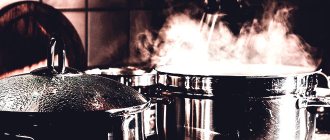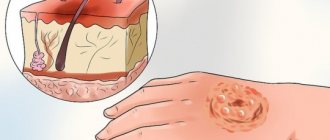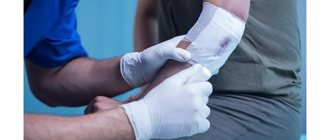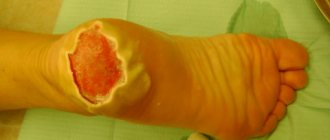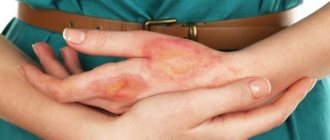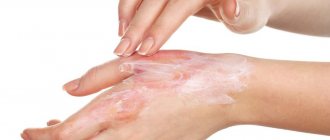Last update: 03/03/2021
A chemical burn occurs when the skin comes into contact with acids, alkalis, salts of heavy metals and other caustic substances. Lesions of the epidermis upon contact with substances are divided into four degrees of severity:
- I degree – slight redness and pain from touching.
- Stage II – the appearance of bubbles with clear liquid.
- III degree – large blisters filled with cloudy liquid and bloody discharge, impaired sensitivity.
- IV degree – damage to all tissues down to the bone.
Regardless of the degree, first aid for a chemical burn is the same. In case of severe injuries (from stage III), you need to call a doctor, and then begin providing first aid.
Severity of burn injuries
Unlike acid, which causes dry coagulation of skin protein and creates a protective dry scab, alkali penetrates more deeply, liquefies and loosens tissue, and the damaged surface has a whitish-gray “cooked” appearance. Therefore, minor burns from alkalis are very rare.
If assistance is not provided, the severity of the burn increases due to the penetration of the substance deep into the tissue. Only a doctor can accurately determine the severity of alkali burns.
There are 4 degrees according to the depth of tissue damage:
- I – partial damage to the surface layer of the skin (epidermis), manifested by swelling and redness,
- II – complete liquefaction of the epidermis, manifested by its wrinkling, detachment, formation of watery blisters,
- III – is divided into 2 degrees: IIIA with damage to the skin itself up to the basal layer and IIIB with damage to the entire thickness of the skin with the basal layer up to the subcutaneous fatty tissue, manifested by the presence of deep wet wounds with dark areas of necrosis,
- IV – underlying tissues are destroyed along with the skin: muscles, ligaments, bones, looks like a black-gray area with a continuous wound surface, complete loss of skin sensitivity.
Why do skin burns occur from household chemicals?
When purchasing detergents and cleaning products, many people pay attention only to the stated effect, but do not read the information about safety precautions and even less often study the composition. This is important, since the composition of household chemicals almost always includes ingredients that are hazardous to the skin . It can be:
- anionic surfactants;
- caustic soda;
- potassium hydroxide;
- sodium hypochlorite;
- ethylenediaminetetraacetic acid.
The presence of any of these ingredients in cleaning products requires compliance with safety precautions. They are aggressive to the skin. You can only work with these substances even for a short time while wearing gloves. Ignoring the instructions for use may result in burns. The skin is injured due to contact with reagents, and then recovers for a long time. An unsightly scar may remain at the site of the lesion.
Providing first aid for alkali burns
The main task when providing first aid is to stop the action of the alkali, clean the surface of the wound, and protect it from infection. What to do if you are burned by alkali:
- Eliminate skin contact with alkali. To do this, you need to quickly free the damaged area from contact with clothing soaked in the substance and place it under running water for at least 20 minutes.
If dry quicklime gets on your skin, it should not be washed off immediately with water. This will create an alkaline solution and worsen the burn. First you need to shake off, blow off, remove the powder from the skin with a soft cloth and only then rinse with water.
- Neutralize the remaining alkali on the skin with a weakly acidic solution - 1-2% boric or citric acid, vinegar, lemon juice diluted with water 1:4. This can be done if it is known for sure that alkali has come into contact with the skin. In doubtful cases, neutralization with acid may lead to an undesirable chemical reaction and deterioration.
- Treat the wound with any antiseptic solution (miramistin, chlorhexidine, furatsilin) or a special anti-burn spray.
- Cover the wound with an aseptic gauze bandage.
- Take the victim to the hospital.
If necessary, give the patient an anesthetic, and for extensive burns, drink plenty of fluids.
How to treat the consequences of burns with household chemicals?
Some scars are completely painless and are considered a cosmetic defect, while others cause discomfort and require treatment. It is possible to smooth out the surface of the skin and lighten red-burgundy scars, but there is no talk of 100% removal of scars. Thin light stripes will most likely remain forever. This is due to the fact that when the skin is traumatized, its natural pattern is disrupted. To make the scar as invisible as possible, you can consult a dermatologist or solve the problem at home yourself.
You can get a free consultation from our specialist!
doctor Svetlana Viktorovna Ogorodnikova.
doctor
Cosmetology procedures
After burns from household chemicals, scars of all types can remain: thin normotrophic, protruding hypertrophic or keloid, as well as atrophic, reminiscent of chickenpox. The cosmetologist’s task is to even out the relief, start skin regeneration, fill the missing volume or eliminate excess scar tissue. There are different techniques available for scar correction. Here are the most effective of them:
- Laser resurfacing . The outer, pathologically altered layer of connective tissue is destroyed during the procedure. At this point, the active construction of healthy cells and the production of fresh collagen begins, due to which the skin texture is evened out. Several sessions and a serious period of rehabilitation are required, as the procedure is quite painful.
- Microdermabrasion I. Another option for hardware skin resurfacing is treatment with crystalline aluminum oxide. The upper stratum corneum is carefully removed and the formation of new cells is stimulated. The skin becomes even and smooth. Volumetric scars gradually decrease.
- Introduction of fillers . This procedure allows you to temporarily smooth out the skin texture by filling areas with atrophic scars with hyaluronic acid. Fillers stimulate tissue regeneration and collagen synthesis. After injection, the skin will become softer and more elastic.
- Acid deep peels . A special solution carefully removes the top layer of the epidermis. This helps to renew the skin and reduce the size of scars. This method is suitable for correcting atrophic scars in complex therapy.
Cosmetic procedures are effective, but removing a scar in one session will not work. The larger and brighter the scar, the more often and longer you will have to visit a dermatologist. The duration of the course also depends on the chosen technique. With laser resurfacing or microdermabrasion, 3-4 procedures are sufficient. Fillers need to be injected regularly every 6-12 months. When correcting using peelings, you will need at least 6-8 sessions. It is important to remember that all procedures have contraindications and are prescribed strictly by a specialist.
What should you not do if you have a burn?
In case of an alkali burn, you should not immediately water the damaged area with an acidic solution without first rinsing it with water. A chemical reaction can make the condition worse, especially if it is not known which solution came into contact with the skin.
Also, you should not immediately try to wipe the solution from the skin with a napkin or piece of cloth, this will further injure the wound. Neither before nor after washing the wound is it permissible to apply fats, oils, or fatty creams to it. They clog skin pores, disrupting breathing and thermoregulation, creating conditions for the development of infection.
Features of a chemical burn
Alkali burns most often lead to dangerous complications. For example, some other aggressive substances immediately react with the skin. It is corroded, but the main part of the chemical does not penetrate deeper.
With alkali everything is different. It may not form a burn crust and quickly penetrates into the deep layers of the skin. At the site of interaction between alkali and skin, a loose, light-colored scab appears. Damaged tissue is released slowly, making healing difficult. This also increases the risk of scarring at the site of alkaline burns.
When a chemical comes into contact with the skin, it appears:
- Irritation;
- Edema;
- Redness;
- Increasing pain that becomes unbearable in case of a burn with high concentration alkali;
- Numbness.
In some cases, victims report feeling as if their skin was “soapy.”
If the concentration of alkali was weak and it did not act on the skin for long, then the person would suffer a superficial burn. The skin will become slightly burgundy, a dull pain and burning sensation will appear.
In severe cases, when deep layers of skin are damaged, pus may form underneath. This creates an additional risk of inflammation.
Treatment of burn wounds at home
If the burn wounds are small and not very deep, then treatment of the burn with alkali can be carried out at home using medications prescribed by a doctor, supplementing them with folk remedies, if possible. You need to visit your doctor regularly and follow his recommendations.
Use of drugs
Alkaline burns are dangerous because infection easily develops in areas of wet necrosis. Therefore, in the acute stage, antibacterial agents are prescribed - antiseptic solutions. They moisten a sterile napkin and change it 2-3 times a day until the wound is completely cleansed and “dried” so that there is no purulent discharge. Solutions of Miramistin and Chlorhexidine work well.
To quickly remove necrotic tissue, Iruksol enzyme ointment is widely used; it dissolves dead areas and has an antiseptic effect. First, the wound is washed with an antiseptic, then ointment is applied for a day.
A cleansed granulating wound needs agents that stimulate the healing process. The most effective ointments are Solcoseryl, Actovegin, and if there is still a lot of discharge, use a Peloidin solution prepared on the basis of medicinal mud. Wound dressings are done once a day.
Traditional methods
Among the folk methods for burns, the application of all kinds of gruels and mixtures of grated vegetables, fats and oils should be excluded. Preference should be given to products that undergo heat treatment. You can treat alkali burns with decoctions and herbal infusions:
- daisies,
- Calendula,
- mint,
- Hop cones,
- St. John's wort.
The possibility of using any folk medicine for burns must be agreed with a doctor.
You can prepare an herbal mixture by taking equal parts of each component, brew 1 tablespoon of the mixture with a glass of boiling water, it is better to hold it in a water bath for 10-15 minutes, then strain into a boiled bowl and cool. Apply to the wound on a moistened sterile napkin 2-3 times a day.
Freshly squeezed juice of aloe or Kalanchoe leaves gives a good antibacterial and wound-healing effect.
It is carefully squeezed into a clean container, moistened with a sterile napkin, and applied to the wound daily. A decoction of oak bark and strong tea brewing will help relieve pain and itching around the wound. Prepare at the rate of 1 tablespoon per 1 glass of boiling water, leave on low heat for 5 minutes. Apply several times a day for half an hour.
Experts' opinion
Based on the results of numerous clinical studies, La-Cri products are recommended by the St. Petersburg branch of the Union of Pediatricians of Russia.
According to the results of clinical studies conducted by the Union of Pediatricians of Russia, it was proven that when using a complex of products, the level of skin moisture decreased by 4% in comparison, and in the group that used placebo, the level of moisture decreased by 9%.
The conducted clinical study proves the high efficiency, safety and tolerability of products for daily skin care of children with mild and moderate forms of atopic dermatitis and during remission, accompanied by a decrease in the quality of life of patients. As a result of therapy, a decrease in the activity of the inflammatory process, a decrease in dryness, itching and flaking was noted.
Cream "La-Cri" for sensitive skin:
- reduces itching and irritation;
- relieves skin redness;
- moisturizes and gently cares for the skin.
Sources:
- Mancini A. J., Krouchuk D. P., Pediatric dermatology. Publisher: Practical Medicine, Directory, 2018
- Kildiyarova Rita Rafgatovna, Pediatrician for every day. Guide for doctors, publishing house GEOTAR-Media, 2022.
- B.A. Shamov, I.G. Safiullina, A.B. Beshimova, T.B. Shamov, Differential diagnosis of atopic dermatitis, Journal of Practical Medicine, 2011
- Fokina R.A., Atopic dermatitis: stages of development of classification forms, Siberian Medical Journal, 2007
Eye burn from alkali
When a liquid alkali solution gets into the eyes, a tear partially reduces its concentration and washes it away. Therefore, severe eye burns occur with heavy exposure to alkali, especially quicklime dust.
Interacting with the thin membranes of the eye, they destroy them, causing clouding and blurred vision. The conjunctiva of the eyelids and lacrimal ducts are also subject to burns, and in case of severe damage, deeper layers are affected, right down to the retina.
The first thing to do if alkali gets into your eye is to rinse it thoroughly with running water under the tap or from a bottle.
In this case, it is necessary to keep the eyelids open and slightly retracted so that the water completely washes the entire surface of the eye and the conjunctiva of the eyelids. The position of the patient's body should be such that the rinsing water flows outward - towards the temple area.
After this, rinse the eye well with a 1-2% aqueous solution of boric acid to neutralize the remaining alkali. Then the eye is covered with an aseptic bandage, and the patient is taken to the doctor.
Basic safety rules
All alkaline solutions should be kept where children cannot reach them. Quite often, children are accidentally doused with dangerous reagents while trying to open bottles of liquid that interest them. In this case, it is not enough that the containers are closed, since a child may well break them.
When working with alkaline products, wear rubber gloves. If the substance has a strong odor, then a protective mask is needed. After all, even inhaling the vapors of some reagents can cause poisoning.
Possible complications
Complications of alkali burns can be general and local. General ones develop in case of extensive and deep damage:
- Burn hypovolemic shock due to fluid loss,
- Poor circulation due to blood thickening, thrombosis,
- Impaired liver and kidney function associated with intoxication,
- Sepsis due to infection of extensive burn surfaces.
Local consequences can be in the form of wound suppuration, prolonged non-healing, the formation of rough keloid scars that limit mobility or are a cosmetic defect.
On the part of the eyes, the most common development is clouding of the cornea - a cataract; with severe burns, the deeper media of the eye are also affected, up to complete loss of vision.
When should you see a doctor?
It should be taken as a rule that in case of a burn with alkali, regardless of its area and location, it is necessary to consult a doctor. The degree of the burn is difficult to immediately determine, especially for a person without medical education.
In case of burns to any area of the body, the victim must be taken to a trauma center, or the emergency department of traumatology or surgery.
For minor burns, you can see a surgeon or traumatologist at the clinic. Eye burns should be examined by an ophthalmologist as soon as possible. If the injury occurred in a rural area where there is no hospital nearby, you must contact a paramedic-midwife station. The paramedic will provide first aid and decide on further actions.
Caring for burn-damaged skin
The more attention you pay to caring for your skin after a chemical burn, the faster the surface will heal and the less likely you are to be left with a scar forever.
The rules of care are simple: do not use substances that irritate the skin. These include almost all alcohol-based products, fragrances and alkaline compounds (soaps, shampoos). Use creams that do not contain potent substances or allergens. They will soften the skin, provide enhanced nutrition for quick treatment of chemical burns and protect the epidermis from possible damage.
La-Cri cream was developed by doctors to care for the most sensitive skin, including those damaged by chemical burns. There are no allergens in it (therefore they can be used even in baby skin care), but there are many nourishing plant extracts that are responsible for regeneration.
